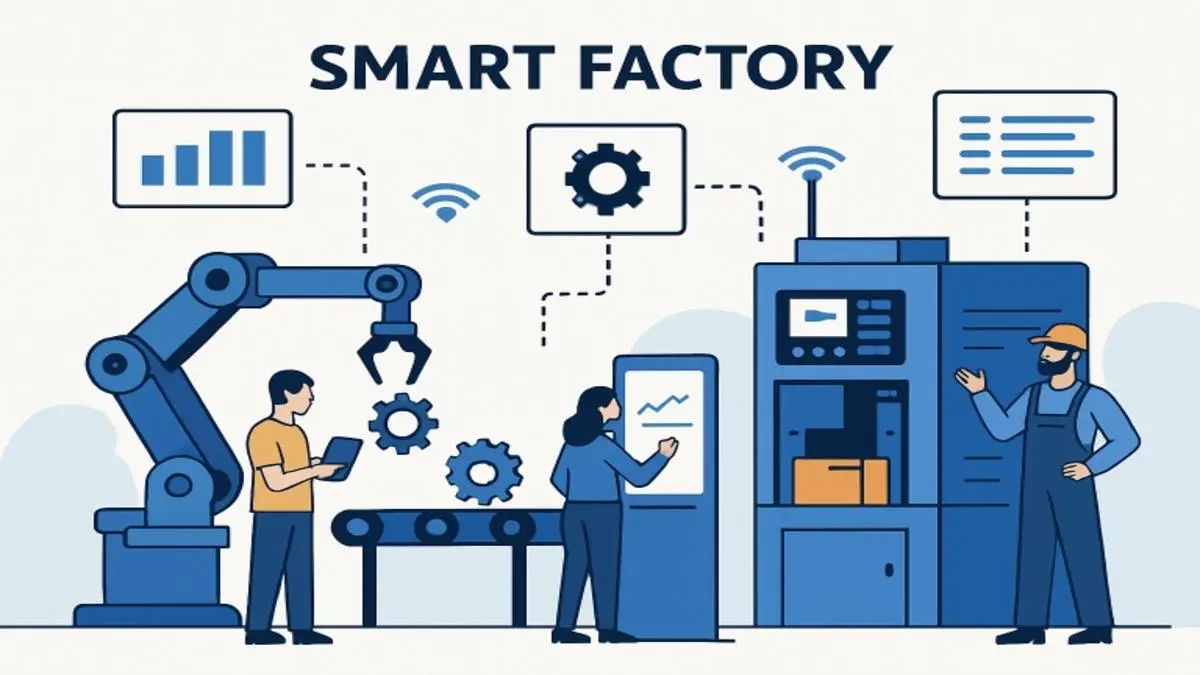GENERAL
Smart Manufacturing Trends: Preparing for Tomorrow’s Factories

Key Takeaways
- 5G networks are revolutionizing real-time factory data and remote automation, bringing latency-sensitive applications like robotic surgery and process automation within reach.
- IIoT empowers manufacturers with improved process oversight and predictability, enabling businesses of all sizes to move towards fully autonomous operations.
- Digital twins provide unprecedented testing capabilities, enabling the simulation of numerous ‘what-if’ scenarios and the optimization of manufacturing workflows with minimal risk.
- Green manufacturing is no longer an option, but a requirement for industry leadership, building trust with eco-conscious stakeholders, and meeting increasingly stringent regulatory expectations.
- Blockchain and RFID are setting new standards for transparency and trust in the supply chain, providing the visibility needed to streamline operations and validate ethical sourcing claims.
- 3D printing drives customization and resource savings, reshaping production economics and fundamentally rethinking approaches to prototyping, repairs, and mass customization.
Table of Contents
Modern manufacturing is undergoing a remarkable transformation powered by cutting-edge technologies and forward-thinking strategies. The landscape is evolving so rapidly that businesses must proactively update their operational models to avoid falling behind competitors who are faster to adopt and integrate modern tools. Businesses that embrace these evolutions position themselves to thrive in tomorrow’s competitive landscape. As connectivity increases and data flows more freely, solutions like manufacturing communication services are becoming integral for enabling seamless collaboration and responsive operations across the factory floor. The digital connectivity now extends beyond simple communication, influencing everything from remote equipment monitoring to AI-powered predictive analytics, granting unprecedented control and flexibility to those willing to innovate.
From digital replicas of production lines to sustainable practices and automated supply chains, innovations define future factories. The pressure to adapt quickly is external (global competition and customer demand) and internal (company culture shift to digital). Quick adaptation is vital for scaling or resilience, with early adoption unlocking efficiency, safety, and agility. Leaders are better equipped to handle disruptions like supply shocks, labor shortages, or regulations, ensuring smarter, safer, more profitable operations.
Integration of 5G Networks
As manufacturers expand digital infrastructure, 5G technology is central to change. Its high bandwidth and reliability greatly improve data collection from machine and sensor networks, removing previous transmission limits. Fast, reliable 5G allows instant data exchange and minimal lag, enabling efficient machine-to-machine (M2M) communication, asset tracking, and remote controls—transforming responsiveness and automation. Real-time data supports advanced robotics and autonomous vehicles, with seamless device communication. Future facilities depend on 5G to enable smart solutions that boost throughput and safety. Early adopters have seen increased visibility and speed, prompting industry investments for higher productivity and better decision-making in connected factories.
Industrial Internet of Things (IIoT)
The IIoT, the backbone of Industry 4.0, collects and analyzes information from a distributed network of smart devices embedded across production systems. Unlike conventional approaches, IIoT systems automatically monitor machine health, energy consumption, and throughput, feeding this data into AI models for continuous process refinement. These sensors reveal patterns in machine performance and help proactively predict required maintenance, minimizing unplanned downtime. For quality assurance, IIoT can flag defects as soon as they arise, reducing scrap rates and improving bottlenecks. IIoT adoption delivers long-term value by supporting real-time quality assurance, optimizing energy consumption, and driving continuous improvement initiatives across global factories. Data-driven operations also enhance profitability and employee safety, as automated alerts minimize the risk of accidents and prevent lengthy disruptions.
Digital Twins and Virtual Simulations
Digital twins create a virtual mirror of real-world assets, operations, or products. Advancements in sensor and modeling technology enable these digital replicas to update in real-time, reflecting the current state of every machine and subsystem within a facility. Manufacturers utilize these digital counterparts to simulate, test, and validate scenarios before modifying shop floor processes or introducing new products. This risk-free environment enables engineers to experiment with factors such as speed, temperature, and material loads without incurring any real-world risks. Teams can optimize production schedules, identify bottlenecks, and test the impact of new product lines—all before incurring the actual costs or delays associated with physical trials. Virtual simulations using digital twins reduce costs and accelerate innovation—often compressing product development timelines from months to weeks. The adoption rate is expected to surge by 2025 as more organizations recognize their potential to fuel rapid, evidence-based decision-making.
Blockchain and RFID Technologies
Blockchain technology is redefining transparency and trust across complex supply chains. With the ability to document every handoff in a product’s journey, blockchain not only proves authenticity but also enables quick responses in the case of recalls or audits. By enabling secure, tamper-proof records of every component’s origin and movement, manufacturers can verify the authenticity of parts, track compliance, and confirm the ethical sourcing of materials. RFID solutions complement blockchain by providing real-time visibility into inventory, finished products, and high-value assets—resulting in greater stock accuracy, streamlined recalls, and more efficient logistics. These technologies significantly reduce manual paperwork and errors, freeing operations teams to focus on value-added work. As these solutions mature and lower adoption costs, expect rapid expansion, particularly in sectors such as automotive, electronics, and pharmaceuticals, where tracking and compliance are crucial.
Sustainability and Green Manufacturing
Market leaders now prioritize sustainability alongside productivity. Effective green manufacturing initiatives begin with energy auditing and careful analysis of production waste, identifying opportunities to reduce emissions and switch to renewable power. Manufacturers innovate by monitoring and minimizing their environmental impact—cutting energy consumption, optimizing resource use, and recycling waste wherever possible. Many are leveraging digitalization, modular setups, and real-time analytics to identify energy-intensive processes and redesign them to boost efficiency. Furthermore, they often partner with suppliers who share environmental commitments, ensuring sustainability across the entire value chain. According to McKinsey & Company, these sustainability strategies reduce operational costs, enhance brand reputation, and help businesses comply with evolving global regulations. Green initiatives also increase consumer loyalty and differentiate companies in international markets.
3D Printing (Additive Manufacturing)
3D printing is reaching new heights in mainstream manufacturing. This layer-by-layer approach shortens the time between design and deployment, effectively eliminating the need for expensive tooling and complex setups. This additive technique enables the on-demand production of customized or complex parts, resulting in reduced waste compared to traditional subtractive methods. Beyond prototyping, manufacturers are now leveraging 3D printing to build replacement components, rapid test tools, and even end-use products. Companies can adapt quickly to design changes without incurring high costs for new inventory, creating ultra-responsive supply chains that keep pace with dynamic market needs. This fosters agility in meeting changing customer requirements and significantly reduces lead times. The flexibility of 3D printing is expected to expand its influence across aerospace, healthcare, and automotive manufacturing in the years to come.
Conclusion
The convergence of interconnected systems, virtual modeling, and eco-friendly operations marks the next frontier in smart manufacturing. The future will undoubtedly be defined by companies that can harness these tools, adapt strategies in real-time, and respond to both market demand and regulatory constraints with agility. Enterprises that integrate these innovations will secure greater operational efficiency, sustainable growth, and unmatched adaptability in the face of shifting market needs and technological advancements.
-

 GENERAL5 months ago
GENERAL5 months agoChristofle – For Those Who Dream of Family Heirloom Silver
-

 SPORTS7 months ago
SPORTS7 months agoDiscover the World of Football with Streameast: Watch Your Favorite Leagues and Tournaments
-

 GENERAL4 months ago
GENERAL4 months agoUncovering the World of кинокрадко: The Dark Side of Film Piracy
-

 GENERAL2 months ago
GENERAL2 months agoATFBooru: Anime, Gaming, and Subculture Imageboard























